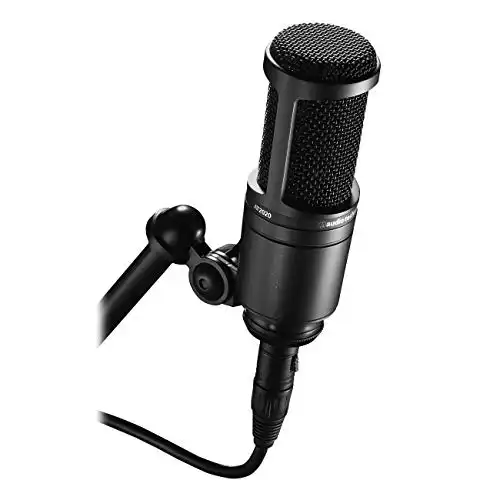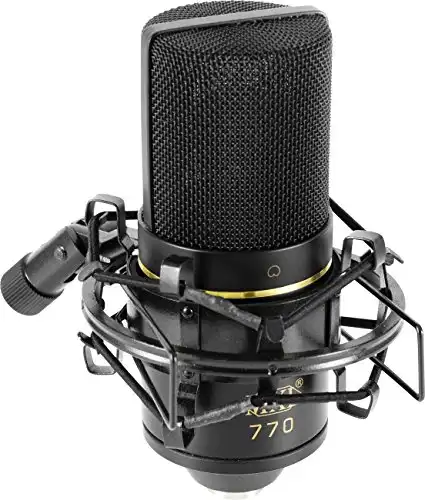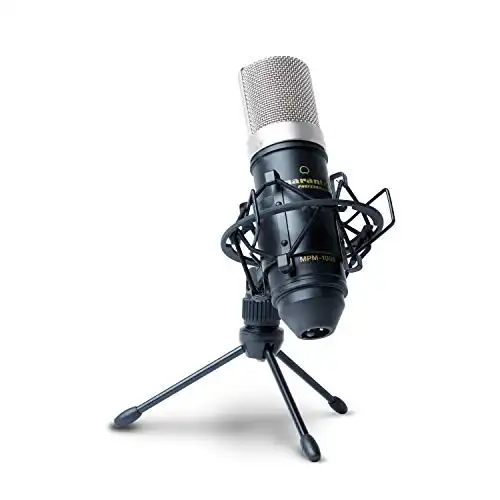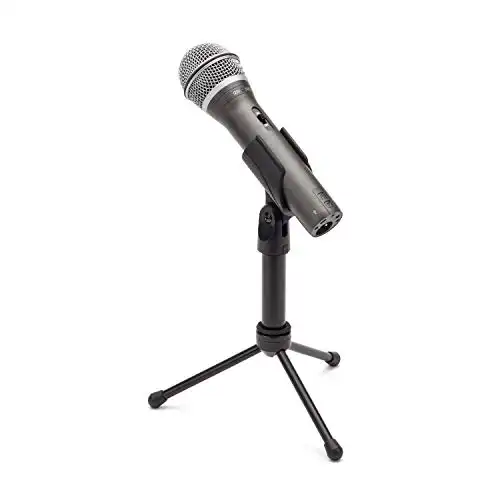In the world of technology, some things are just too good to try and upgrade. The XLR cable is one of these.
Having been the go-to choice for sound engineers for almost 70 years, XLR connections are strong and secure. Their reputation is so good that many microphones still feature XLR ports as their only connection choice, even in the modern age.
But why should you choose an XLR microphone? Well, first and foremost, you’ll be able to create a much more stable connection to your recording device. Plug and play connections, such as USB and headphone jacks, are much easier to unplug accidentally.
They are generally more durable too. This makes them perfect for life on the road, and they won’t easily suffer any damage when being tossed into storage cases or thrown around by over-zealous baggage handlers.

As with all technology, however, some XLR microphones are better suited for certain recording jobs than others. Factor in the endless technical jargon, and this can make choosing the perfect mic for your needs a little more confusing.
That’s why we’ve done the hard work for you. Below, we’ve compiled a list of the very best XLR microphones. We’ve also put together a handy buying guide that’s packed with advice on what to keep an eye out for when you’re shopping around.
So, please make yourself comfortable, keep reading, and join us on our journey through XLR microphones. Let’s start by taking a look at our top pick.
Table of Contents
1. Audio-Technica AT2020 XLR Studio Microphone
Whether you’re recording at home or in a professional studio, the
It also records with a cardioid pickup pattern. This focuses on sound coming from a 180º arc directly in front of the microphone whilst simultaneously blocking out any background noise.
This makes it ideal for podcasting, narrating an audiobook, and even for recording outdoors.
A mesh grille protects the condenser capsule, and the entire microphone has a sturdy, durable feel to it. It features a threaded stand mount too, which allows you to secure it to a boom arm or tripod desk stand with ease.
This microphone is easy to connect to a mixer or audio interface with an XLR cable. This also helps to ensure your connection stays strong and stable throughout your recording session.
Comes complete with a storage case and includes a two-year limited warranty.
See the Latest Pricing on Amazon
Pros:
- Features a wide frequency range of 40Hz-20KHz that can pick up a variety of vocal tones
- Records with a cardioid pickup pattern that focuses on vocals and blocks out background noise
- Has a sturdy, durable build and features a mesh grille that protects the condenser capsule
- Allows you to establish a secure connection with an XLR cable easily
- Includes a storage case and a two-year limited warranty
Cons:
- Does not come with an XLR cable included
2. MXL 770 Cardioid Condenser Microphone
Featuring a balanced bass response and high-end clarity, the MXL 770 Cardioid Condenser Microphone is ideal for live streaming as well as recording vocals and instruments. This makes it an extremely versatile, multipurpose piece of recording equipment.
It’s able to capture such amazing audio by operating with a cardioid pickup pattern. This focuses only on sound coming from in front of the microphone and makes sure that any background noise doesn’t appear on your finished recording.
The stylish, patented design gives it a professional appearance, and it would fit in perfectly with any studio setup. It’s easy to mount and comes with a sturdy shock mount that can be threaded to any existing microphone stand.
You can establish a secure connection to your recording device through the 3-pin XLR cable port located conveniently on the microphone’s bottom.
This keeps the cable out of your way whilst your recording. It also works harmoniously with the side-address design to ensure you have the most comfortable recording experience possible.
See the Latest Pricing on Amazon
Pros:
- Features a balanced bass response and high-end clarity to produce high-quality audio on every recording
- Operates with a cardioid pickup pattern to enhance vocals and eliminate background noise
- Allows you to establish a secure connection to your recording device through an XLR port
- Comes with a shock mount for easy threading to any existing microphone stand
- Has a durable, stylish design and comes complete with a 12-month warranty
Cons:
- Requires a 48V Phantom power supply to operate
3. Marantz Professional MPM1000 Studio Microphone
If you’re looking for a fantastic XLR microphone but you’re on a fairly tight budget, you can’t go wrong with the MPM1000 Studio Microphone from Marantz Professional.
Featuring a condenser capsule protected by a mesh grille, it has a bunch of features you’d usually find in a much more expensive model.
One of the standout features is the wide frequency range of 20HZ-20KHz. This works together with the cardioid polar pattern to ensure your vocals are captured with the highest clarity possible.
It also helps to drown out any ambient noise and prevent it from being picked up whilst recording.
It’s never been easier to establish a secure connection to your recording device, either. Attach an XLR cable to the bottom of the mic, and you’re good to go.
The XLR port placement also helps keep the cable out of your way when you’re recording.
This fantastic microphone comes with a windscreen that can help eliminate plosives and breath sounds. It’s also ideal if you plan on recording outdoors at any point.
A tripod desk stand is also included to keep the microphone steady and leave your hands free throughout your recording session.
See the Latest Pricing on Amazon
Pros:
- A fantastic microphone for anybody working with a tight budget
- Has a frequency range of 20Hz-20KHz that can comfortably pick up a variety of vocal tones
- Records with a cardioid pickup pattern that focuses on direct-sound and eliminates background noise
- It also has a conveniently located XLR port for establishing a secure connection to your recording device.
- Includes a windscreen and a tripod desk stand
Cons:
- The included tripod desk stand is not adjustable, so you may have to think a little more about where you set up your microphone.
4. Samson Q2U Dynamic Microphone
If you like to switch between recording devices regularly and need a microphone that allows you to do this, you need to look no further than the Samson Q2U Dynamic Microphone.
Featuring both XLR and USB connection ports, it’s one of the most versatile mics available.
Its outstanding recording capabilities also match its superb versatility. The front-address design works with the cardioid polar pickup pattern to ensure that only sound coming from directly in front of the microphone is recorded.
This also ensures that no ambient noise is picked up.
This microphone has a wide frequency range of 50Hz-15KHz to produce crystal clear vocals across various voice types. This makes it ideal for both solo podcasting and interviewing guests.
You’ll also be able to monitor your levels whilst you’re recording and hear yourself clearly thanks to the integrated 3.5mm headphone jack.
This operates with zero-latency, so there will be no annoying echoes or feedback. A tripod desk stand is also included to keep your mic steady whilst you’re recording.
See the Latest Pricing on Amazon
Pros:
- Can be connected to your recording device with either an XLR cable or USB cable
- Features a cardioid pickup pattern that enhances vocal sound and eliminates ambient noise
- Has a wide frequency range of 50HZ-15KHz that can pick up a variety of vocal tones
- The integrated 3.5mm headphone jack allows for zero-latency monitoring.
- Includes a tripod stand to keep the mic steady and leave your hands free
Cons:
- Doesn’t come with any pop filters or windscreens to eliminate plosives and breath noise
5. Shure PGA58-XLR Dynamic Vocal Microphone
The Shure PGA58-XLR features a specially designed cartridge that enhances the natural clarity in vocal tones. This makes it the ideal choice for producing the smooth, conversational sound you want when you’re recording a podcast.
As with all great vocal microphones, it uses a cardioid pickup pattern to focus solely on your voice. This type of polar pickup pattern also rejects unwanted ambient sounds and further enhances your recorded vocals’ quality.
It’s easy to create a secure connection to your recording device through the XLR port located on the microphone’s bottom. You can easily secure the microphone to an existing stand as well with the included adapter.
There’s a discrete on/off button located directly on the microphone’s front that allows for easy operation. This button is also slightly indented, so there’s less risk of accidentally turning the microphone off during use.
Once you’ve finished recording, you can safely store your microphone and cables away in the included storage pouch.
See the Latest Pricing on Amazon
Pros:
- Features a specially designed cartridge that enhances natural vocal tones
- Records with a cardioid pickup pattern to further enhance vocals whilst eliminating ambient noise
- Is easy to set up and can be connected to any recording device with an XLR cable
- It also features an on/off button for easy operation.
- Highly durable and comes complete with a stand adapter and storage pouch.
Cons:
- Doesn’t include as many additional accessories like some other vocal microphones
Buyer’s Guide
You may think that buying an XLR microphone is a fairly straightforward affair. However, once you start looking into the technical terms and each microphone’s style, things can start to become a little more complicated.
To help make things a little clearer, we’ve listed some key points to consider when you’re shopping around below.
These will also help you better understand any confusing jargon and set you on the right track to finding the best XLR microphone for your recording needs.
Connection
The first thing you need to be certain of is that your current recording device will support an XLR connection. If you’re using a mixer or an audio interface, you’ll most probably have one.
However, if you’re recording directly onto a computer, you may need to invest in an XLR to USB adapter.
Some microphones give you the ability to connect through an XLR cable and a USB port.
This would be a great option for anybody that likes to switch up their recording devices. You’ll also save a lot of money since you won’t need to purchase separate microphones for different devices.
When you’re thinking about your connection, take a minute to consider your studio setup too. If you’ve got a smaller space, then a shorter XLR cable might work better for you. Likewise, if you’re recording in a larger studio, a longer cable may be a better option.
Style of Microphone
Once you’re 100% certain that you’re recording equipment can support an XLR microphone, it’s time to think about what style of microphone you’d like. There are loads of different styles available, but it comes down to more than aesthetics.
A side-address microphone will allow you to speak more comfortably into it, and you won’t have to worry too much about it being angled directly at your mouth.
This is perfect for podcasting as the more comfortable you feel, the more natural-sounding your voice tone will be.
You might decide to go for a front-address microphone. This is the style of microphone that you may be more familiar with and, as such, might feel more comfortable speaking into.
Pickup Pattern
Microphones use polar pickup patterns to record their surroundings, and this is something that needs to be considered in line with what you’re using your microphone for. Are you a solo podcaster, or do you interview guests each week?
Let’s take a closer look at two of the most popular pickup patterns for podcasters.
The first is a cardioid pickup pattern. This concentrates solely on sound coming from a 180º arc directly in front of the microphone. Doing this blocks out any ambient noise and allows your vocals to be recorded clearly and concisely.
A cardioid pickup pattern would be the best choice for a solo podcaster or anybody recording in an outdoor environment.
The second is a bidirectional pickup pattern. This concentrates on sound coming from either side of the microphone and shares the mic’s sensitivity between both sides equally.
This makes it a great choice for anybody with a co-host or guest, allowing you to share a microphone without sacrificing audio quality.
Frequency Response
No two voices are the same, and different vocal tones can be hard for a mic to pick up clearly, so your chosen microphone’s frequency response is another important thing to consider.
Put simply, the wider the frequency response range, the more vocal tones it will be able to produce into warm, smooth audio. Look for a microphone with a frequency response between 18Hz-20KHz for the best results.
Durability
You may not always be recording in a studio and might want to take your show out on the road every so often. So, with that in mind, it’s important to make sure that your microphone is as durable as possible too.
Any microphone with all-metal construction and a mesh grille surrounding the condenser capsule will be tough enough to handle a few accidental bumps or knocks.
If it comes with a storage case, that’s even better, as it will give you somewhere to safely stash your mic away when it’s not in use.
Extra Accessories
It’s always worth seeing what else you can get for your money, and microphones are no exception to this rule. Many come with extra accessories that won’t just give you more bang for your buck but will also help enhance your recording experience.
Windscreens and pop filters are amongst the very best extra accessories to look out for. These will help to eliminate any plosives or breath sounds from being recorded.
They’ll also reduce any annoying wind noise the microphone might pick up when you’re recording outdoors.
A tripod desk stand is another great accessory and will keep the microphone held securely in position for your whilst you speak. This leaves your hands free to check your notes or gesticulate, giving you a more comfortable feeling that will translate on the microphone.
Frequently Asked Questions
What is an XLR connection?
An XLR connection is a type of cable that is most commonly used in professional recording situations. It creates a strong, secure connection between a microphone and a recording device and is harder to unplug accidentally than a USB connection.
It is characterized by three ‘male’ pins that plug into a ‘female’ XLR port.




